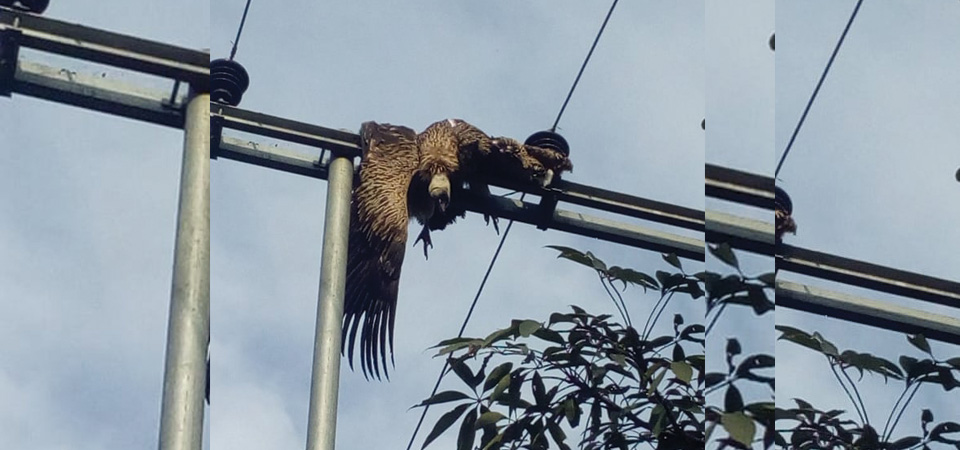Naked wire posing threats to vulture

By Amar Raj Naharki
Tanahun, Feb. 15: The vultures, which are on the list of endangered species, are in danger of dying after being electrocuted near a Cow Conservation Center in Tanahun as their food is left near the electric poles, which are connected with naked electric wires.
When the protected birds started to die, conservationists asked concerned bodies to keep the carcasses far from the electric poles or cover wires with insulators.
They also said that the environment saving species would become extinct if they are not protected.
While the dead cows were left to feed the vultures at the Cow Conservation Center in Shishuwa Bhateri, Ward No. 10, by the Byas Municipality, some of the vultures were electrocuted while coming to eat in large numbers, said Ram Prasad Sapkota, a local.
As there is a lack of space to relocate the Centre, Sapkota says that the electric poles should be protected by managing the electrical wires. Three vultures died on Friday alone while eating the carcass, he informed.
According to Sapkota, three to four vultures used to die when a dead cow was thrown away and about 100 vultures have died so far. “If the wire is left uncovered, the vulture will be killed due to electric shock. Steps should be taken on time for its protection,” said Sapkota.
He informed that the vultures died due to electric shock as the Cow Conservation Center was near the Bhorletar-Damauli 33 KV transmission line of Nepal Electricity Authority.
There are about 100 cows in the Centre set up to manage loose quadrupeds. Most of the old cows are in the Centre. Dead cows and bulls have been left unattended to feed the vultures.
Tulsiram Sapkota, ward chairman of Byas Municipality Ward No. 10, said that the NEA should manage the open wires as it is not possible to relocate the Centre.
Hundreds of different types of vultures come to the Centre every day to eat carcasses, which is set up by collecting loose cattle from Sishuwa-Bhateri, chairman Sakpota said.
“If we do not throw carcasses, the vulture will die of starvation,” Sapkota added.
Vulture conservationists have said that most of the vultures are on the list of endangered species so have to be protected.
Hemant Dhakal, a member of the Vulture Expert Group and secretary of the Pokhara Bird Society, said that the wire can be saved by covering it with polythene pipe.
He said that if the Byas Municipality spent Rs. 400,000 to 500,000, vultures could be saved by putting insulators in the wires.
Hundreds of vultures die every year from collisions and electric shocks from tall electric poles and wires. Development work has been carried out without studying the problems of various species of raptor, Dhakal said.
Chief District Officer Bishwa Prakash Aryal informed that a request has been made to the Byas Municipality to find out the cause of the accident and make appropriate arrangements to control vulture accident.
A letter has been written to the District Coordinating Committee on Friday to coordinate with the Municipality to make arrangements not to use open wire around Cow Conservation Centre, said Komal Raj Kafle, chief of the Division Forest Office, Tanahu.
According to Dhakal, until two decades ago, when livestock died, it was thrown away from the settlement. The carcass that was left behind was an easy food for the vulture. Today the trend has changed. Dead animals are not thrown out as much attention is paid to hygiene.
The vultures, which belong to the group of birds of prey, are large carnivores. They do not hunt by themselves. They only eat carcasses, so they are also called natural scavengers.
Recent News

Do not make expressions casting dout on election: EC
14 Apr, 2022
CM Bhatta says may New Year 2079 BS inspire positive thinking
14 Apr, 2022
Three new cases, 44 recoveries in 24 hours
14 Apr, 2022
689 climbers of 84 teams so far acquire permits for climbing various peaks this spring season
14 Apr, 2022
How the rising cost of living crisis is impacting Nepal
14 Apr, 2022
US military confirms an interstellar meteor collided with Earth
14 Apr, 2022
Valneva Covid vaccine approved for use in UK
14 Apr, 2022
Chair Prachanda highlights need of unity among Maoist, Communist forces
14 Apr, 2022
Ranbir Kapoor and Alia Bhatt: Bollywood toasts star couple on wedding
14 Apr, 2022
President Bhandari confers decorations (Photo Feature)
14 Apr, 2022











